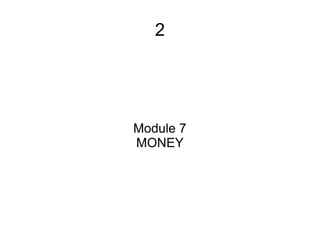
Module 7 2 money
- 2. MONEY "Money is the promisory instrument, issued by the Government to facilitate the exchange transactional process in commercial or rewarding or penalizing" Money came into existence from the barter system to exchange of metals and presently each country has their own currency as a medium of exchange to facilitate their citizens as well as others for commercial or social transactions. Money has STATIC AND DYNAMIC functions
- 3. MONEY The STATIC functions of Money: 1. Medium of exchange, 2. Has a value and a unit of account, 3. It can be in paper, metal or bank instrument. 4. Declared by the Govt as a legal tender. 5. It can be used as a standard of deferred payments.
- 4. Functions of Money The DYNAMIC function of Money are: 1. Money can determine 'Economic Trend'., 2. Money can influence, 'Consumption and Production'., 3. Money states the, 'Purchasing Power' and acts as a medium of exchange.
- 5. FEATURES OF MONEY Features of Money: 1. Money should be durable, it should not get easily decomposed or degraded., 2. Money should be divisibility, it should be available in fractions, Re1 to Rs 1000 which permits citizens to divide as they want., 3. Money should be handy, easily transportable., 4. Money should be far from duplicacy. If currency can be duplicated, it will loose its value.
- 6. CLASSIFICATION OF MONEY Money can be classified into: 1. Monetary System Criterion or Physical characteristics, 2. Acceptability Criterion, 3. Money of account and Money Proper, 4. Other types of money
- 7. CLASSIFICATION OF MONEY Money can be classified into: 1. Monetary System Criterion or Physical characteristics,: Money can be in Paper Form or Metalic Form, where both has their limitation in the exchange process.
- 8. CLASSIFICATION OF MONEY Money can be classified into: 2. Acceptability Criterion,: Money can be in the form of legal tender money that is which individuals use for exchange to buy or sell, while the other is the optional money or non legal tender money, which are also called as 'BANK MONEY" (Cheques or Drafts).
- 9. CLASSIFICATION OF MONEY Money can be classified into: 3. Money of account and Money Proper,: Keynes distinquished between money of account and money paper, where money of account is the transactions pertaining to purchasing power while Money Proper is the specific currency where the settlement is done, for instance, Indian Rupees.
- 10. CLASSIFICATION OF MONEY 4. Other Types of Money, : a. Commodity Money (Based on products value), b. Fiat Money: (Based on value by Govt Ex: Gold), c. Credit Money: (Based on Credit or Financial Instruments of an individual), d. Soft Money: (Based on promise by Govt for exchange and is issued in the form of paper), e. Hard Money: (Based on the value of commodity Ex: Gold is a hard money), f. Commercial Bank Money (Based on finalization by the bank) g. Digital Money: (Money in the Electronic Form), h. Fiduciary Money: (Legal or Ethical relationship of trust between 2 parties)
- 11. MONEY SUPPLY Money Supply (M) = M1 + M2 + M3 + M4 Where: M1 = Currency with Public + Demand Deposit with Banking System + Other deposit with RBI, M2 = M1 + Savings Deposits at Post Offices, M3 = M1 + Time Deposites in Banks, M4 = M1 + All deposites in PO Savings, excluding NSC (National Savings Certificates)
- 12. CREDIT CONTROL Credit Control is the tool used by the RBI, to control the demand and supply of Money (Liquidity). Credit Control is the method used by RBI to 'Bring Economic Development with Stability'. Meaning: Credit Control refers to the process of monitoring and collecting the money owned to a business. This includes the measures and procedures adopted by a firm to ensure that its credit customers pay their accounts.
- 13. CREDIT CONTROL Objectives of Credit Control: ● To encourage overall growth of the priority sector, ● To keep a check on channelization of credit, ● To control inflation and deflation, ● To boost the economy with adequate flow of credit to various sectors, ● To develop the economy.
- 14. CREDIT CONTROL Methods to measure the credit control are as follows: ● Quatitative Method, ● Qualitative Method. (Take down the same points How RBI takes measures to control the Money Supply in the market)
